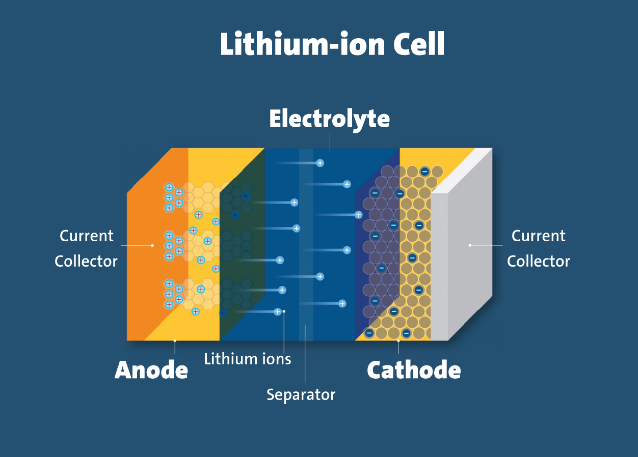リチウム電池のパワーをエネルギー貯蔵に活用

急速に進化する世界では、エネルギーの需要は絶え間なく、このエネルギーを貯蔵する効果的な方法を見つけることが極めて重要な課題となっています。エネルギー貯蔵は現代社会において重要な役割を果たし、エネルギーの生産と消費のギャップを埋めることができます。太陽光や風力などの再生可能エネルギー源が普及するにつれて、信頼性の高いエネルギー貯蔵ソリューションの必要性がかつてないほど明らかになっています。
このエネルギー貯蔵革命の中心には、真のゲームチェンジャーが存在します。 リチウム電池これらの控えめなパワーハウスは、エネルギー貯蔵の状況を一変させ、私たちのエネルギー需要の複雑さに対処する比類のない利点を提供してきました。電気自動車への電力供給から再生可能エネルギー源によって生成された余剰エネルギーの貯蔵まで、 リチウム電池 効率的で持続可能かつアクセスしやすいエネルギー貯蔵の新しい時代を切り開きます。
このブログでは、 リチウム電池 エネルギー貯蔵のための太陽電池。その内部の仕組み、再生可能エネルギーの利用における役割、そしてそれが電力を供給するさまざまな用途について探ります。住宅用から大規模なグリッドレベルの設備まで、 リチウム電池 クリーンエネルギーが前例のない効率で活用される未来へと私たちを導いています。
さあ、力を解き放つ旅に出ましょう リチウム電池彼らがどのようにエネルギー貯蔵を改革し、より持続可能で回復力があり、より明るいエネルギーの未来に向けて私たちを推進しているかを理解します。
リチウム電池を理解する
リチウム電池の構造構成
エネルギー貯蔵ソリューションの分野では、 リチウム電池 イノベーションの先駆者として際立っています。その重要性を真に理解するには、その複雑な構成と機能を深く掘り下げることが不可欠です。 リチウム電池 エネルギーの貯蔵と放出を相乗的に可能にする 3 つの基本コンポーネントで構成されています。

アノード: 多くの場合グラファイトで作られたアノードは、充電段階でリチウムイオンのホストとして機能します。これらのイオンはアノードの構造内に蓄積され、放電時に放出されます。
陰極: 一方、カソードは放電時にアノードから放出されたリチウムイオンを受け取ります。カソード材料の種類によって、バッテリーの全体的な性能特性が決まります。
電解質: 電解質は、陽極と陰極の間の橋渡しとして機能し、リチウムイオンの移動を促進します。電解質は通常、溶媒に溶解したリチウム塩の溶液であり、イオンが 2 つの電極間を移動できるようにします。
リチウム電池の種類
リチウム電池の分野では、3 つの有力候補が君臨しています。 リチウムイオン(Li-ion)電池, リン酸鉄リチウム (LiFePO4) 電池、 と 三元リチウム電池それぞれが独自の属性を持ち、異なるアプリケーションに適しています。
リチウムイオン(Li-ion)電池:
リチウムイオン電池は、その優れたエネルギー密度とコンパクトなサイズにより、ポータブル電子機器や電気自動車業界に革命をもたらしました。スマートフォン、ノートパソコン、電気自動車などの機器を支える原動力です。カソード材料は用途によって異なります。電子機器にはリチウムコバルト酸化物 (LiCoO2)、電気自動車にはリチウムニッケルコバルトマンガン酸化物 (LiNiCoMnO2) が使用されています。 これらの利点により、リチウムイオン電池は さまざまな業界における多用途のエネルギー貯蔵ソリューションの第一の選択肢

リン酸鉄リチウム(LiFePO4)電池:
LiFePO4バッテリーは 安全性, 長寿、熱安定性を備えています。これらのバッテリーは、信頼性とセキュリティが最も重要となるアプリケーションに最適です。 再生可能エネルギー貯蔵 電気自動車のパワートレインに使用されています。正極材料であるリン酸鉄リチウムは安全性を高めるだけでなく、 バッテリーのサイクル寿命そのため、長期的なエネルギー貯蔵に適した選択肢となっています。

三進法 リチウム電池:>
三元リチウム電池は ニッケル, コバルト、 と マンガン カソード材料に含まれています。このブレンドはエネルギー密度と寿命のバランスが取れており、電気自動車やポータブル電子機器に適しています。

リチウム電池の利点
リチウム電池の汎用性と信頼性は、優れたエネルギー貯蔵ソリューションとして際立つさまざまな利点から生まれています。エネルギー貯蔵ソリューションの分野では、リチウム電池は効率性、汎用性、持続可能性のチャンピオンとして浮上しています。高いエネルギー密度から長いサイクル寿命まで、これらの電池がどのように機能するかを見てみましょう。 電池はエネルギーの利用と貯蔵の方法に革命をもたらしている.
(1)高エネルギー密度
リチウム電池の最も印象的な特徴の一つは、その驚くべき エネルギー密度コンパクトで軽量な構造の中に大量のエネルギーを蓄えることができます。この特性は、ポータブル デバイスや電気自動車など、スペースが限られているシナリオで特に有利です。 リチウム電池 洗練された管理しやすいフォーム ファクターを維持しながら、これらのデバイスが効率的に動作できるようにします。
(2)長寿命
リチウム電池は長期間の使用に耐えられるよう設計されている数百から数千回の充電と放電サイクルを経ても、容量の大幅な低下はありません。 サイクル寿命の延長 これらのバッテリーは長期間にわたって動作し、効率性を維持します。この長寿命により、さまざまな用途でコスト効率の高い選択肢となります。 アプリケーション交換の回数が少なくなるため、費用と環境への影響が軽減されます。
(3)急速充電機能
急速な 充電はリチウム電池の特徴である、利便性と生産性を向上させます。これらのバッテリーは急速充電が可能で、ダウンタイムが短縮され、より効率的なエネルギー補給が可能になります。この利点は、電気自動車の充電ステーションや緊急バックアップシステムなど、エネルギーへのアクセスが迅速である必要があるシナリオでは特に重要です。ただし、急速充電はバッテリー寿命に優しくないこと、そしてそれをマスターすることは重要です。 専門的な課金措置 バッテリー寿命を最大限に延ばすことができます。
(4)自己放電率が低い
リチウム電池は低い 自己放電率つまり、長期間使用されていない場合でも、蓄えられたエネルギーが保持されます。使用していないときに大幅なエネルギー損失が発生する他の種類のバッテリーとは異なり、リチウム バッテリーは蓄えられたエネルギーを効率的に維持します。この機能により、数週間または数か月間保管した後でも、必要なときにエネルギーを利用できます。
(5)広い動作温度範囲
多くのリチウム電池は、 幅広い温度範囲この適応性により信頼性が向上し、さまざまな環境に適したものになります。リチウム電池は極寒から灼熱まで性能を維持するため、さまざまな条件下で信頼性が求められる用途に最適です。
(6)環境への配慮
従来の鉛蓄電池と比較してリチウム電池は環境に優しい。毒性物質が少なく、エネルギー効率の良い 製造プロセス環境への影響が軽減されるため、二酸化炭素排出量を最小限に抑えることを目指す組織や業界にとって、責任ある選択肢となります。
エネルギー貯蔵におけるリチウム電池
エネルギーソリューションのダイナミックな状況において、リチウム電池の役割は、特に再生可能エネルギーの統合の分野でますます重要になっています。この章では、再生可能エネルギーをグリッドにシームレスに統合する上でリチウム電池が果たす不可欠な役割に焦点を当てます。 バッテリーは太陽光パネルで発電された余剰エネルギーを効果的に蓄える また、電力網の安定性の維持、負荷分散の最適化、ピーク需要の管理におけるエネルギー貯蔵の重要性についても詳しく説明します。
再生可能エネルギーにおけるリチウム電池の重要性
太陽光や風力などの再生可能エネルギーは、その持続可能な特性によりエネルギーの状況を一変させました。しかし、その断続的な性質は、継続的なエネルギー供給を実現する上で課題となります。 リチウム電池ステップ 信頼できるパートナーとして。
リチウム電池はエネルギーの生産と消費の間のギャップを埋め、生産が停滞しているときでも再生可能エネルギー源からの安定した電力供給を確保します。
リチウム電池が再生可能エネルギーを蓄える仕組み
太陽光パネルと風力タービンは、豊富でクリーンな資源を活用することで発電に革命をもたらしました。
しかし、これらのエネルギー源は、すぐに消費されるよりも多くのエネルギーを生成することがよくあります。この余剰エネルギーは、利用されないまま放置されると無駄になります。リチウム電池は、余剰エネルギーを蓄えるという優れたソリューションを提供します。
いつ 太陽光パネルは必要以上の電力を生産する余剰電力はリチウム電池に送られ、実質的に貯蔵庫に変換されます。これらの電池は生産期間中に余剰電力を蓄え、曇りの日や夜間に利用できるようにします。
同様に、風力タービンは突風時に余剰エネルギーをリチウム電池に送り、風が弱まったときに安定したエネルギー供給を確保することができます。
再生可能エネルギーにおけるリチウム電池の役割
電力網の安定性は、信頼できるエネルギー供給を維持するために最も重要です。再生可能エネルギー源の変動はエネルギー生産の変動につながり、電力網の不均衡を生じさせます。ここでエネルギー貯蔵システム、特にリチウム電池が役立ちます。
グリッドの安定化: リチウム電池は、発電量が多い期間に余分なエネルギーを吸収し、需要がピークに達したときにそれを放出することで、安定器として機能します。この動的なバッファリングにより、過負荷や電力の中断を防ぎ、電気のスムーズな流れを確保します。
バランス調整: リチウム電池は負荷分散に優れており、電力網全体にわたってエネルギーを最適に分配します。オフピーク時には余剰エネルギーが蓄えられ、ピーク時にはこの蓄えられたエネルギーが放電されるため、電力網に負担をかけずに安定したエネルギー供給が確保されます。
リチウム電池は、再生可能エネルギー統合の分野で陰の立役者として浮上しています。太陽光パネルや風力タービンからの余剰エネルギーを蓄える能力により、散発的なエネルギー源を効果的に電力網の信頼できる供給源に変えることができます。さらに、これらのエネルギー貯蔵ソリューションは、電力網の安定性を維持し、エネルギー負荷のバランスを取り、ピーク需要を効率的に管理する上で極めて重要です。世界が持続可能なエネルギーの新時代を迎える中、リチウム電池は最前線に立ち、次世代のために回復力のある環境に優しいエネルギー環境を確保しています。
エネルギー貯蔵にリチウム電池を使用する利点
エネルギー貯蔵の分野は絶えず進化しており、リチウム電池は効率性、汎用性、持続可能性を体現する画期的な電池として注目を集めています。この章では、リチウム電池が幅広い用途でエネルギー貯蔵の最適な選択肢となる多面的な利点を明らかにします。その優れたエネルギー効率からコンパクトな設計と拡張性、そして長期的なコスト効率まで、リチウム電池のさまざまな利点について詳しく見ていきましょう。 リチウム電池の理由 エネルギー貯蔵ソリューションの革新の最前線に立っています。
a. エネルギー効率
リチウム電池をエネルギー貯蔵に利用することの最も重要な利点の 1 つは、その優れたエネルギー効率です。これらの電池は、貯蔵プロセスと放電プロセスの両方でエネルギーの浪費を最小限に抑えるように設計されています。
従来のバッテリー技術では、大幅なエネルギー損失が発生するため、 内部抵抗 リチウム電池は、優れた耐熱性と放熱性により、エネルギーの無駄を最小限に抑えます。
この効率により、より多くの使用可能なエネルギーが保持され、効果的に利用され、全体的なエネルギー収量が向上し、システム パフォーマンスが最適化されます。
b. コンパクトさと拡張性
リチウム電池はコンパクトなサイズとモジュール設計で知られており、最小限の物理的設置面積で大量のエネルギーを貯蔵できます。
このコンパクトさは、住宅用太陽光発電システム、ポータブル電子機器、電気自動車など、スペースが限られている用途で特に有利です。小さな容積内に大きなエネルギー容量を収容できるため、スペースを節約できるだけでなく、さまざまなセットアップに簡単に統合できます。
さらに、 リチウム電池システムのモジュール性 シームレスな拡張性を実現します。エネルギー貯蔵のニーズが増大するにつれて、追加のバッテリー モジュールをシステムに追加して、大幅な再設計を必要とせずにエネルギー容量を拡張できます。
この拡張性により、ユーザーはエネルギー貯蔵ソリューションを特定の要件に合わせてカスタマイズできるようになり、長期にわたる効率性と適応性が保証されます。
c. 費用対効果
リチウム電池システムの導入にかかる初期コストは他の技術に比べて高くなる場合もありますが、長期的なコスト効率は否定できません。
リチウム電池は、優れた耐久性と信頼性を特徴としており、大きな容量損失なしに多数の充電および放電サイクルに耐えることができます。この長寿命により、電池の寿命全体にわたってメンテナンスおよび交換コストが削減されます。
さらに、蓄積されたエネルギーの効率的な利用と急速充電および放電能力は、エネルギー システムの効率向上に貢献します。この効率は、エネルギーが最大化され、頻繁なメンテナンスや交換の必要性が最小限に抑えられるため、長期的には目に見える経済的利益につながります。
バッテリー交換コストが高くなる可能性がある電気自動車などの用途では、リチウム電池の耐久性は長期的な運用費用の面で大きな利点を提供します。 リチウム電池が鉛蓄電池に取って代わった..
エネルギー貯蔵におけるリチウム電池の主な用途
世界が持続可能なエネルギー ソリューションへの移行に努める中、リチウム電池はさまざまな分野で欠かせないツールとして浮上しています。この章では、エネルギー貯蔵におけるリチウム電池の主な用途を詳しく説明し、住宅、商業、産業、グリッド レベルのシナリオにおけるリチウム電池の革新的な役割を紹介します。家庭での余剰太陽エネルギーの活用から大規模なグリッド安定化の実現まで、リチウム電池がエネルギーの状況をどのように変えているのかを探ってみましょう。
住宅用エネルギー貯蔵
リチウム電池は、住宅所有者の太陽エネルギーの利用方法に革命をもたらし、住宅を自給自足のエネルギーハブに変えました。ソーラーパネルとリチウム電池ストレージを統合することで、住宅所有者は日中に生成された余分な太陽エネルギーを貯蔵し、夜間や太陽出力が低下する期間に使用することができます。これにより、クリーンエネルギーの利用が最大化されるだけでなく、グリッド電力への依存が軽減され、潜在的なコスト削減につながります。
さらに、住宅用リチウム電池システムは、住宅所有者にエネルギーの自立と停電時の安全性を提供します。停電が発生しやすい地域では、これらの バッテリーはバックアップ電源として機能する、重要な機器への継続的な電力供給を確保します。この回復力は快適性を高めるだけでなく、緊急時の備えにも貢献します。
ハーベイパウ パワーウォールリチウム電池 は、家庭にぴったり合う太陽エネルギー貯蔵バッテリーです。シンプルでスタイリッシュな外観で、壁掛け式のデザインで家のスペースを節約できます。最も重要なのは、8000回以上のサイクル寿命と90% DODを備えていることです。これは、20年以上にわたって家庭に効率的なエネルギー貯蔵サービスを提供してきたのに十分なものです。
商業および産業用エネルギー貯蔵
リチウム電池は商業および工業分野で幅広く利用されており、企業や産業がエネルギー消費を管理する方法に革命をもたらしています。重要な用途の 1 つはピークシェービングです。これは、需要が低い期間に余剰エネルギーを蓄え、ピーク時に放出することで、需要が高い場合の料金に関連するエネルギーコストを効果的に削減するものです。
さらに、リチウム バッテリー システムにより、企業は需要応答プログラムに参加できます。これらのプログラムは、ピーク需要期間中にエネルギー消費を削減するよう企業に奨励し、電力網への負担を軽減します。蓄えられたエネルギーを活用することで、企業は中断のない運用を確保しながら、エネルギー使用量をシームレスに削減できます。
ハーベイパウ リチウムサーバーラックバッテリー モジュール設計を採用しており、電圧と容量を自由に拡張でき、大規模なエネルギー貯蔵とエネルギー供給を簡単に実現できます。その内部は CATLバッテリー 世界最高の性能を備え、各モジュールにはBMSディスプレイが装備されており、各バッテリーの日常の動作をいつでも監視してメンテナンスと調整を容易にします。商業および産業用エネルギー貯蔵に最適です。
グリッドレベルのエネルギー貯蔵
より大規模なレベルでは、リチウム電池がグリッドレベルのエネルギー貯蔵に波を起こし、エネルギー分配の安定化に極めて重要な役割を果たしています。グリッドの不安定性は、エネルギーの供給と需要の変動によって頻繁に発生します。リチウム バッテリーの設置 動的な貯蔵庫として機能し、余剰期間中に余分なエネルギーを吸収し、需要が高いときに放出することで、一貫したエネルギーの流れを確保します。
さらに、 リチウム電池は停電時の電力網バックアップに貢献する 停電や自然災害が発生しやすい地域では、これらのバッテリーが病院や救急サービスなどの重要なインフラを維持するための信頼性の高いエネルギー源を提供します。この回復力により、困難な時期にコミュニティの安全と幸福が向上します。
リチウム電池の性能に影響を与える要因
リチウム電池がエネルギー貯蔵ソリューションとして注目を浴び、ポータブル電子機器から再生可能エネルギーの統合まで、さまざまな産業に革命をもたらしました。しかし、リチウム電池の性能と寿命は、その固有の機能だけで決まるわけではありません。さまざまな外部要因が、これらの電池の機能と長期にわたる耐久性に重要な役割を果たします。この章では、リチウム電池の性能に影響を与える複雑な影響について掘り下げ、その効果を明らかにし、効率と寿命を最適化する方法についての洞察を提供します。
(1)温度に関する考慮
温度は、リチウム電池の性能に大きく影響する主要な外部要因です。電池は本質的に電気化学システムであり、温度は電池内部の化学反応の速度を制御する上で重要な役割を果たします。
暑さの犠牲: 需要の高い用途や温暖な気候でよく見られる高温により、バッテリー内の化学反応が加速します。これにより、最初はエネルギー出力が増加するかもしれませんが、劣化が進むという代償を伴います。高温で起こる構造変化により、時間の経過とともに容量が低下し、全体的なエネルギー貯蔵能力が低下します。
チルの影響: 一方、低温ではバッテリーの内部抵抗が増加し、エネルギーを効率的に供給する能力が制限されます。これは、需要が高い状況でバッテリーがエネルギーを効率的に放出できず、出力が低下する場合に特に顕著になります。
最適範囲: 推奨温度範囲内にとどまることは非常に重要です。熱管理システムを実装すると、バッテリーを最適な動作条件に維持し、劣化の加速リスクを軽減し、パフォーマンスと寿命を向上させることができます。
(2)放電深度(DoD)
放電深度(DoD) は、再充電前にバッテリーに蓄えられたエネルギーがどれだけ使用されるかを示します。リチウム バッテリーはエネルギー密度が高く、深放電が可能ですが、放電の程度によって寿命が左右されます。
深く掘り下げる: 充電前にバッテリーを完全に放電すると、エネルギーを最大限に利用できるようになりますが、バッテリーのコンポーネントに負担がかかります。 過放電は機械的負担につながり、摩耗を加速させ、時間の経過とともに容量の低下につながります。
浅いアプローチ: 蓄積されたエネルギーの一部のみが使用される部分放電は、バッテリーへのストレスを軽減し、動作寿命を延ばします。浅い放電は、バッテリーの短期的な容量よりも長期的な信頼性を優先する場合に特に効果的です。
綱渡り: バランスをとる エネルギー容量を最大化し、バッテリー寿命を延ばす は不可欠です。バッテリー管理システム (BMS) は、放電深度を制限するようにプログラムできるため、バッテリーが常に限界まで使用されないようになり、寿命が延びます。
(3)保守・監視
定期的なメンテナンスとバッテリーの状態の入念な監視は、リチウムバッテリーの最適なパフォーマンスと寿命を維持する上で重要な役割を果たします。
定期検査: バッテリーシステムの定期的な目視検査を行うことで、物理的な損傷を検出することができます。 漏れ、または潜在的な問題を示唆する異常を検出します。問題をタイムリーに特定することで、さらなる劣化を防ぎ、安全な操作を確保します。
バッテリー管理システム (BMS): 高度な BMS リチウム電池の状態を監視するのに役立ちます。これらのシステムは、充電状態、状態、温度などのパラメータに関するリアルタイムの洞察を提供します。これらの指標を監視することで、新たな問題が発生した場合に早期に介入することができます。
長寿の維持: を通して 予防的メンテナンス 注意深く監視することで、ユーザーはリチウム電池の動作寿命を延ばすことができます。潜在的な問題を早期に解決することで、回復不可能な損傷を防ぎ、長期間にわたって電池が確実に機能することを保証します。
リチウム電池技術の将来動向
リチウム電池は、ポータブル電子機器から再生可能エネルギーへの統合まで、変革を遂げてきました。技術が進化するにつれ、これらのエネルギー貯蔵ソリューションも進化します。この章では、リチウム電池技術の有望な将来の動向を探り、進行中の進歩、固体電池の可能性、環境の持続可能性への重点の高まりに光を当てます。今後を見据えると、リチウム電池の進化は 電池はエネルギー貯蔵を一変させる可能性を秘めている 景観を美しくし、より持続可能な未来を育みます。
1. 研究開発
リチウム電池の世界では、性能、安全性、寿命の向上を目指した研究開発が盛んに行われています。電池化学の革新により、エネルギー密度、充電サイクル、全体的な効率が著しく向上する道が開かれています。
強化電解質: 研究者は、バッテリー部品の安定性を向上させ、サイクル寿命を延ばし、動作中の過熱のリスクを軽減する高度な電解質を研究しています。
シリコンアノード: 従来のグラファイトアノードをシリコンに置き換えると、エネルギー密度が大幅に高まります。ただし、充電サイクル中のシリコンの膨張と収縮などの課題は、革新的な材料と設計によって解決されています。
リチウムを超えて: リチウム硫黄電池やリチウム空気電池などのポストリチウム電池技術の探求は、さらに高いエネルギー密度を実現し、エネルギー貯蔵能力に革命をもたらす可能性を秘めています。
2. 固体電池
リチウム電池技術における大きな飛躍は、固体電池の出現です。この革新的なコンセプトは、従来の液体電解質を固体材料に置き換え、多くの利点を生み出します。
安全性の強化: 固体電池は、液漏れ、火災、熱暴走のリスクを軽減し、個人用デバイスから電気自動車まで、さまざまな用途において本質的に安全な選択肢となります。
より高いエネルギー密度: 固体電池は、より高いエネルギー密度を実現する可能性があり、ポータブル デバイスの寿命を延ばし、電気自動車の走行距離を延ばすことができます。
充電時間の短縮:イオン伝導性が向上した固体 バッテリーはより速い充電を可能にするかもしれない 従来のリチウムイオン電池で安全上のリスクとなる可能性のあるデンドライト成長の懸念がありません。
3. 環境の持続可能性
リチウム電池業界は、電池のライフサイクル全体にわたる環境持続可能性の必要性を痛感しています。
環境に優しい生産: 希少で環境に有害な材料の使用を減らし、エネルギー消費を最適化し、生産中の炭素排出量を最小限に抑えるなど、より持続可能な製造プロセスに向けた取り組みが行われています。
リサイクルへの取り組み: リチウム電池の寿命が尽きると、適切な廃棄とリサイクルが極めて重要になります。効率的なリサイクル方法を開発することで、貴重な材料を回収し、電池廃棄物の環境への影響を軽減できます。
循環型経済: 循環型経済モデルへの移行は、リサイクルを念頭に置いてバッテリーを設計し、バッテリーのライフサイクルの終了時にコンポーネントを効率的に抽出して再利用できるようにすることを目的としています。
適切なリチウム電池システムの選択
エネルギー貯蔵ソリューションの分野では、適切なリチウム バッテリー システムを選択することが、パフォーマンス、効率、長期的なコスト削減に大きく影響する極めて重要な決定となります。この章では、特定のアプリケーションに最適なリチウム バッテリー システムを選択する際に考慮すべき重要な事項と手順について詳しく説明します。
考慮すべき要素
いつ リチウム電池の選択 システムを構築する際には、目的のアプリケーションへの適合性に影響を与える可能性のあるさまざまな要素を考慮することが重要です。
エネルギー要件: 住宅用、商業用、工業用など、エネルギーのニーズを評価します。貯蔵する必要があるエネルギーの量とそれを使用する頻度を理解することは、それらの要件を満たすバッテリー システムを選択する上で不可欠です。
スペースの制限: バッテリー システムを設置するために利用できる物理的なスペースを考慮してください。リチウム バッテリーの構成によって必要なスペースは異なるため、シームレスな統合には、指定されたスペースに収まるものを選択することが不可欠です。
予算: 予算は、購入可能なリチウム バッテリー システムの種類を決定する重要な要素です。エネルギー貯蔵のニーズと財源のバランスを取ることが、費用対効果の高い選択を行う鍵となります。
サイズと容量の計画
適切なバッテリー容量を選択するには、十分なエネルギー貯蔵を確保することと、不必要な過剰を避けることの間の微妙なバランスが必要です。
負荷分析: 負荷分析を実行して、エネルギー消費パターンを把握します。ピーク使用期間と平均エネルギー消費量を特定して、 バッテリーシステムのサイズ 必須。
放電深度(DoD): 希望する放電深度を決めます。これは、再充電前にバッテリーのエネルギーをどれだけ使用するかを指します。放電が深いほど、より大きな容量が必要になる場合があります。 バッテリー容量.
バッテリーの化学: リチウム電池の化学組成によって、エネルギー密度とサイクル寿命が異なります。エネルギーのニーズと予算の制約に合った化学組成を検討してください。
最高のリチウム製造業者を見つける
エネルギーゲームをステップアップしましょう ハーベイパウ CATLが製造するリチウム電池は世界クラスの品質の象徴です。HARVEYPOWリチウム電池工場、半自動生産ライン、レーザー溶接、その他23の大小さまざまな設備を見学しましょう。 生産プロセス完全に透明な生産と 1 対 1 の検査レポートを提供します。そして自信とは? あなたの道を照らす確固たる 12 年間の保証です。
さらに、各製品は30以上のデバイスとシームレスに同期します。 インバータ これまでにない互換性を実現するブランド。何を待っていますか? 強さと約束の組み合わせである HARVEYPOW をご利用ください。より良い明日のために今日を元気にしましょう。
リチウム電池メーカーについて詳しく知る:
- 世界のトップリチウム電池メーカー
- 中国トップ100リチウム電池メーカーリスト
- カスタムリチウム電池のトップメーカー
- トップ Lifepo4 バッテリー メーカー
- 2022年中国のトップ20のLifepo4バッテリーメーカー
- トップLifepo4バッテリー卸売
- エネルギー貯蔵電池のトップメーカー
- 2023 年のトップリチウム電池ブランド
- 南アフリカにおけるリチウム企業の台頭
結論
エネルギー貯蔵用リチウム電池の分野への探求が頂点に達した今、私たちが得た知識を精錬することが不可欠です。この旅を通じて、私たちはリチウム電池が提供する数多くの利点、持続可能なエネルギー環境を形成する上でのその極めて重要な役割、そしてエネルギー貯蔵のニーズに対してこれらのソリューションを検討するようすべての人に強く勧めていることを発見しました。
リチウム電池は、その技術的な特性を超えて、より持続可能なエネルギーの未来への希望の光となっています。再生可能エネルギー源との統合は、二酸化炭素排出量の削減、有限資源への依存度の低減、環境保護への取り組みの強化に向けた移行を示しています。
したがって、エネルギーの旅に乗り出す際には、リチウム電池の可能性は技術革新を超越するものであることを忘れないでください。これは、環境管理への取り組みであり、エネルギー効率への誓約であり、持続可能性に向けた世界的な運動に参加するという約束なのです。
利用可能なオプションを検討し、それらがもたらすメリットを考慮し、より環境に優しく効率的なエネルギー環境への旅に乗り出しましょう。エネルギーの未来はあなたの手の中にあります。一緒にそれを活用しましょう。
もっと詳しく見る トップへ リチウム電池に関する質問!
